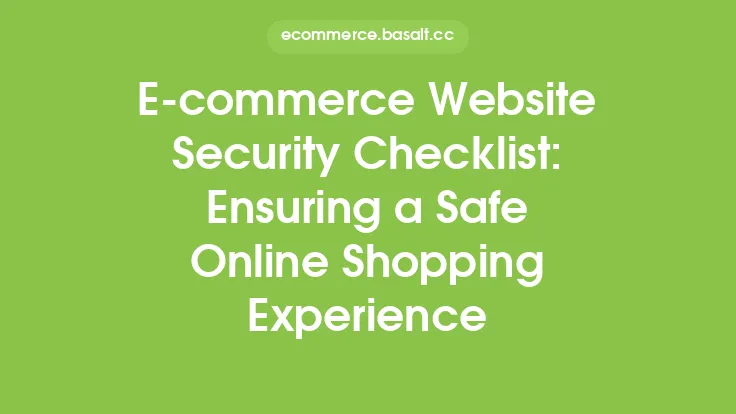In today's digital age, online shopping has become an integral part of our lives. With the rise of e-commerce, consumers are increasingly turning to the internet to purchase goods and services. However, this shift has also led to a growing concern about the safety and security of online transactions. As a result, creating a safe and trusted online shopping environment has become a top priority for e-commerce businesses. This involves implementing various measures to protect customers' sensitive information, prevent fraud, and ensure a seamless shopping experience.
Introduction to E-commerce Security
E-commerce security refers to the measures taken to protect online transactions, customer data, and e-commerce websites from unauthorized access, use, disclosure, disruption, modification, or destruction. This includes protecting against various types of cyber threats, such as hacking, phishing, and malware attacks. A secure e-commerce environment is essential for building trust with customers, preventing financial losses, and maintaining a positive reputation.
Key Components of a Safe Online Shopping Environment
A safe and trusted online shopping environment consists of several key components. These include:
- Secure payment processing: This involves using reputable payment gateways that comply with industry standards, such as PCI-DSS, to process transactions securely.
- Data encryption: This involves using encryption technologies, such as HTTPS, to protect customer data, both in transit and at rest.
- Access control: This involves implementing measures to control access to sensitive areas of the website, such as the admin panel, and ensuring that only authorized personnel have access to customer data.
- Regular security updates and patches: This involves regularly updating software, plugins, and themes to prevent exploitation of known vulnerabilities.
- Monitoring and incident response: This involves continuously monitoring the website for suspicious activity and having a plan in place to respond quickly and effectively in the event of a security incident.
Building Trust with Transparency and Communication
Building trust with customers is critical for creating a safe and trusted online shopping environment. This can be achieved through transparency and communication. E-commerce businesses can build trust by:
- Clearly displaying security badges and trust marks: This includes displaying trust badges, such as SSL certificates, and security seals, such as those from reputable security companies.
- Providing clear and concise information about security practices: This includes providing information about the measures taken to protect customer data and prevent fraud.
- Responding promptly to customer inquiries and concerns: This involves having a dedicated customer support team that can respond quickly and effectively to customer inquiries and concerns.
- Being transparent about data collection and usage: This involves clearly disclosing what data is collected, how it is used, and with whom it is shared.
The Role of Third-Party Verification
Third-party verification plays a crucial role in creating a safe and trusted online shopping environment. This involves using reputable third-party services to verify the identity and legitimacy of the e-commerce business. This can include:
- Business verification: This involves verifying the business's physical address, phone number, and other contact information.
- SSL certificate verification: This involves verifying the SSL certificate to ensure that it is valid and up-to-date.
- Security scanning and testing: This involves regularly scanning and testing the website for vulnerabilities and weaknesses.
Best Practices for Maintaining a Safe Online Shopping Environment
Maintaining a safe and trusted online shopping environment requires ongoing effort and attention. E-commerce businesses can follow best practices, such as:
- Regularly updating software and plugins: This involves keeping all software, plugins, and themes up-to-date to prevent exploitation of known vulnerabilities.
- Monitoring for suspicious activity: This involves continuously monitoring the website for suspicious activity, such as unusual login attempts or changes to customer data.
- Conducting regular security audits: This involves regularly conducting security audits to identify vulnerabilities and weaknesses.
- Providing security awareness training to employees: This involves providing regular security awareness training to employees to ensure that they are aware of the latest security threats and best practices.
Conclusion
Creating a safe and trusted online shopping environment is essential for e-commerce businesses to build trust with customers, prevent financial losses, and maintain a positive reputation. This involves implementing various measures to protect customers' sensitive information, prevent fraud, and ensure a seamless shopping experience. By following best practices, such as regularly updating software and plugins, monitoring for suspicious activity, and providing security awareness training to employees, e-commerce businesses can maintain a safe and trusted online shopping environment. Additionally, building trust with transparency and communication, and using third-party verification services, can help to establish a reputation as a trustworthy and secure e-commerce business.





